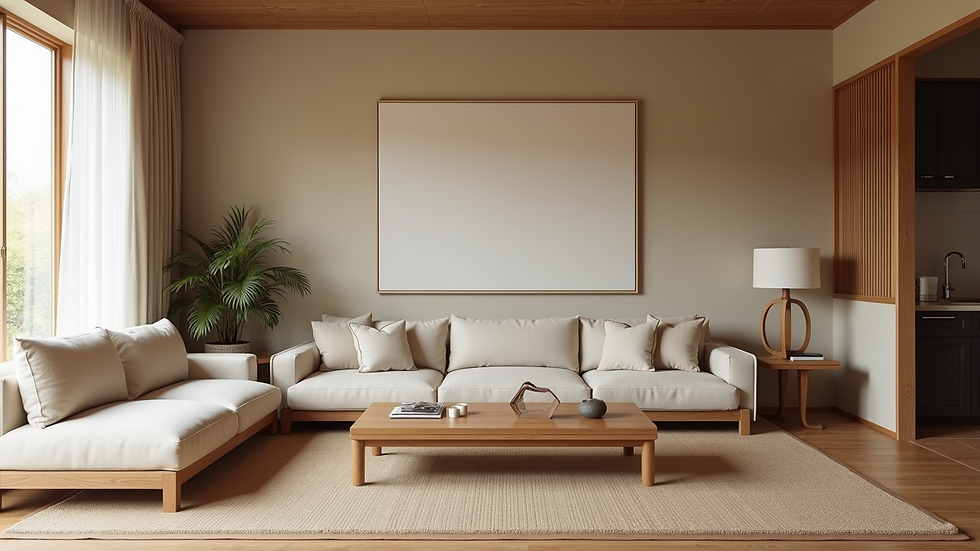Exploring Japandi Moodboard Creation Tips for a Harmonious Interior Design Experience
- Journalising Designers
- Jul 17, 2025
- 3 min read
Creating a harmonious space is not merely about choosing the right furniture or color palette; it involves carefully curating elements that reflect your personal style while promoting tranquility. The Japandi design style, which blends Japanese minimalism and Scandinavian functionality, is a popular choice for many seeking a serene and balanced home environment. One effective way to explore and refine this aesthetic is through moodboarding.
In this post, we will delve into thoughtful tips for creating a Japandi moodboard, enabling you to harmonize your interior design elements and foster an inviting atmosphere.
Understanding the Essence of Japandi
The essence of Japandi revolves around simplicity, function, and the beauty of natural materials. By merging Japanese and Scandinavian design philosophies, Japandi embraces clean lines, neutral color palettes, and the thoughtful use of space.
When embarking on your moodboard creation, it's crucial to understand these core principles, as they will guide your choices. Aim for a balance between aesthetics and functionality, ensuring each element serves a purpose while contributing to a cohesive look.
Gathering Inspiration for Your Moodboard
Before you begin compiling images and materials, take time to gather inspiration. Browse through design magazines, websites, and social media platforms to discover elements that resonate with you. Look for images that highlight natural textures, warm tones, and a sense of calmness.
Consider creating a Pinterest board or a physical scrapbook where you can compile your favorite ideas.

Selecting a Color Palette
An essential aspect of a Japandi moodboard is the color palette. Opt for muted, earthy tones combined with soft whites and grays. These colors evoke a sense of tranquility and reflect the natural world.
When choosing your palette, think about how different shades can harmonize with various materials, such as wood, stone, and fabric. Incorporate swatches of paint, fabric, or even photographs of materials that resonate with your vision.
Incorporating Textures and Materials
Textures play a significant role in Japandi interiors, enhancing the sensory experience of a space. Consider incorporating natural materials like wood, linen, cotton, and ceramics into your moodboard.
Gather samples or images of these materials to visualize how they can work together, create harmony, and add depth to your design. Ensure that each texture complements the overall aesthetic while reflecting your unique style.

Choosing Furniture and Accessories
In Japandi design, furniture pieces are often simple and functional. Look for furniture that embodies clean lines, minimal ornamentation, and natural materials.
When compiling your moodboard, include images of potential furniture choices, ensuring they align with your designated color palette and textures. Don’t forget to consider accessories like decorative objects, throw pillows, and rugs that also adhere to the overall design philosophy.
Finding Balance and Harmony
As you assemble your moodboard, focus on achieving balance and harmony. The interplay between different elements, including color, texture, and form, is crucial for a cohesive look.
Experiment with the layout of your moodboard, moving elements around until you find the right balance. This exercise will not only visually refine your design but also enhance your understanding of how various aspects come together to create a unified space.
Finalizing Your Moodboard
Once you have gathered a collection of images, textures, and colors that resonate with your Japandi-inspired vision, it’s time to finalize your moodboard.
Assemble your selected elements on a larger board, either digitally or physically. Ensure everything is aligned with the ideals of Japandi design—simplicity, functionality, and the beauty of nature. This finalized moodboard will serve as your visual guide throughout the design process.
Utilizing Your Moodboard for Interior Design
Now that you have your Japandi moodboard, it’s time to put your ideas into action. Use it as a reference when selecting paint colors, furniture, and accessories.
Keep your moodboard visible during the selection process to maintain alignment with your intended aesthetic. A well-curated moodboard will help you navigate your design choices and keep you focused on the harmonious experience you aim to create.
Embracing Personal Touches
While Japandi styling emphasizes simplicity and minimalism, it’s essential to add personal touches that reflect your personality. Incorporate items that hold sentimental value or showcase your unique style to create a space that feels authentically you.
Personal elements can provide warmth and character to your Japandi environment, highlighting that simplicity doesn’t have to mean sacrificing individuality.
Conclusion
Creating a Japandi moodboard can be a fulfilling and insightful step in your interior design journey. By understanding the style's core principles and carefully curating your elements, you’re well on your way to developing a harmonious and inviting space.
Remember to gather inspiration, select a thoughtful color palette, incorporate rich textures, and ensure harmony throughout your choices. Most importantly, be sure to embrace your personality, allowing your space to truly reflect who you are.
Happy designing!
